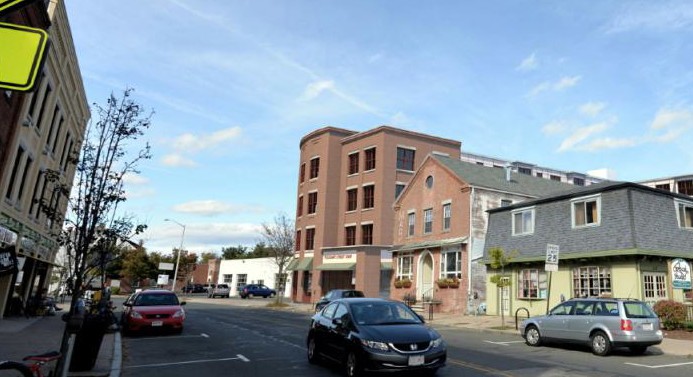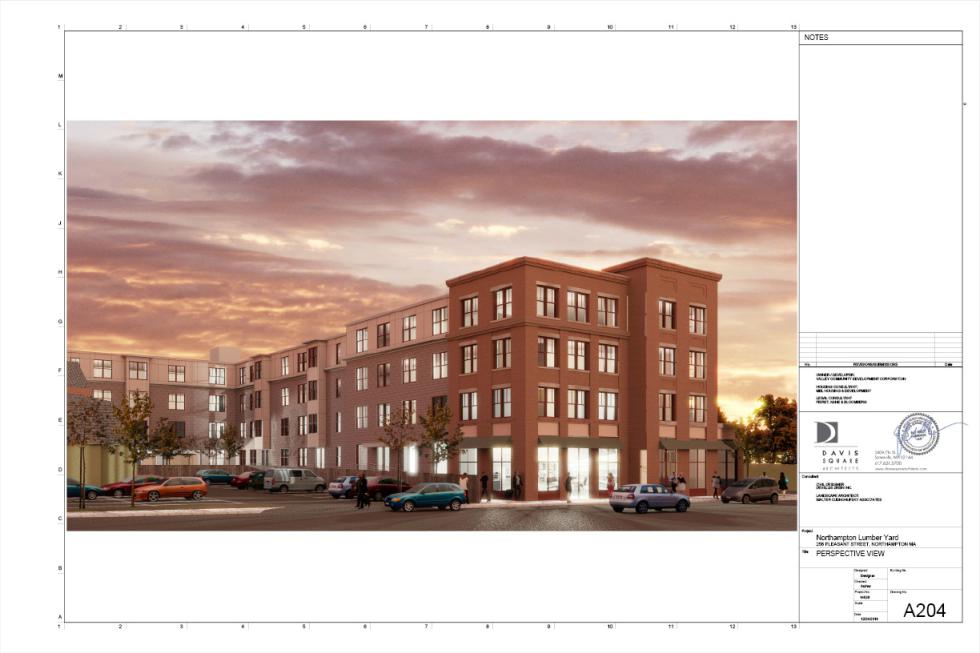Northampton — Mary Finn, co-owner of the Optical Studio on Pleasant Street and the building that houses it, is not happy about plans to develop a large affordable housing complex that, if carried through, could dwarf her two-story building.
The complex — a $20 million Valley Community Development Corporation (CDC) project — is planned for the former Northampton Lumber Co. lot, which has been vacant for about two years. The lumber buildings are intended for demolition and, as designed, the four-story L-shaped building would have frontage on both Pleasant and Holyoke Streets. It would have space for 55 affordable units, plus about 3,000 square feet of commercial space on the first floor.
“It’s a very aggressive building for the site,” Finn says.
Finn isn’t the only one with concerns. Neighboring property owners Amy Royal, Rich LePage, and Jordi Herold have questioned the venture in public meetings, criticizing the planned building’s size, site plan, and aesthetics.
After hearing criticism from the community, CDC director Joanne Campbell says architect Clifford Boehmer will present updated designs previewed in a public forum on Dec. 29 — which include a shortened height, increased first-floor commercial space and use of traditional brick masonry — to the Planning Board and Central Business Architecture Committee during a joint hearing on Jan. 8.
If those boards endorse the plans, the City Council could vote Jan. 15 on appropriating $300,000 in Community Preservation Act funds for the development — money Campbell says is crucial to the project. Affordable units, she says, are intended for single occupants making up to $25,000 a year and for families earning up to $52,000 per year.
The city’s Office of Planning and Sustainability has endorsed the project, along with another nonprofit project HAPHousing has in the works for Northampton Lodging, a structure filled with both affordable and market-rate rental units. The HAPHousing project has won site plan approval, a special permit, and City Council approval for $300,000 in CPA funds. It will demolish the existing Northampton Lodging and build a five-story mixed-use, mixed-income building.
Combined, the two Pleasant Street developments would add more than 100 affordable units to downtown Northampton. Supporters say the projects align with the city’s broader plans for Pleasant Street, which include improved granite curbing and bike lanes, higher-density housing, and measures to ease traffic congestion and improve the appearance of the southern gateway to downtown. The city is working on a comprehensive plan based on ideas generated in two community brainstorming sessions called “Pleasant Futures” held by the Planning Board.
Madeline Blanchette, 46, of Valley Street, says she is excited by the increase in modestly priced housing. She says while the neighborhood is already the most affordable in town, she watches her neighbors struggle to make rent as houses are bought and sold and rents go up. Increasingly, she says, teachers, social workers, police officers, baristas, and artists can’t afford to live in Northampton.
Blanchette is a public defender and her husband is a musician. She says artists are especially hard-pressed to afford Northampton.
“This is an issue that I think about a lot because it’s something a lot of my friends and colleagues are dealing with,” says Blanchette. “The arts are hit really hard in Northampton, which is really ironic because Northampton is really thought of as this arts mecca.”
Blanchette says the neighborhood is gaining the new Northampton Community Arts Trust building — slated for the former Universal Fitness space at 33 Hawley Street — and is ripe for more affordable housing for creatives.
She adds that she is saddened by those who worry about the people who may apply for affordable housing. She says the CDC project will be a well-maintained building with on-site management.
“The strongest objectors aren’t residents but property owners,” Blanchette says. “It would be tragic in my opinion if they took an aggressive hold-out stance.”
Mary Finn says Pleasant Street improvements have been discussed for years. She says she has no problem with an affordable housing complex on the lumberyard lot, but she says the building is too large and the process has been too rushed. She’d like to see a smaller building and more play space for the many children expected to live there, and she’d like the CDC to explore the possibility of rehabilitating the site’s mill building before demolishing it.
She says the Royal building, which abuts the planned building on the south side, is a restored mill building, as is Jordi Herold’s building to the north of the lot. To restore the old building in between, she says, would make the development more harmonious with its neighbors.
Finn says people entering downtown through the Pleasant Street gateway should see a building that “complements the surrounding buildings — a building that’s in rhythm with the others.” She says the requested CPA funds should not be awarded to the current designs because they violate CPA guidelines that call for buildings to “respect existing historic character” and not “overwhelm their neighbors.”
Finn says the CDC has a track record of pushing things through with little community input. She says the proposed project will change the face of Pleasant Street and it’s important for challenging perspectives to be heard and considered before rushing to construction.
“It seems that city councilors are just starting to puzzle over this — which is understandable, I know they’re busy — but we owe it to ourselves to find something people feel good about and fund it appropriately,” Finn says.
Campbell says CDC is responding to needs outlined by the city and they have to move quickly so that for-profit developers don’t swoop in and take desirable sites. She says after the reduction of the building’s height, the addition of more commercial space to the first floor, and the incorporation of more traditional masonry work into the building, most earlier opponents have come around to the project.
Campbell says she is confident the building’s revised plans will gain approval in Northampton. After facing opposition in Easthampton, the CDC advanced its project by invoking Chapter 40B, a state statute that enables local zoning boards to pass affordable housing developments under flexible rules if the municipality does not meet a 10 percent affordable housing threshold. But Campbell said that wouldn’t work in Northampton, which already has 12 percent affordable housing.
She says the mill building on-site is not in the position to be repurposed because it is in poor condition and the building is set back too far from the street. She said it can be tricky to balance neighbors’ wishes with the needs in the community.
“I think potentially it’s the beginning of a change for the area,” Campbell says. “Oftentimes change is difficult.”
Rick Beaupre, 38, a local artist, lived in Northampton for a decade before recently moving to Williamsburg because, he says, his rent was too much for too little space. He says his apartment was so small that he was simultaneously paying $875 for rent and an additional $200 for studio space in Easthampton. Now he says, he pays $775 for his three-bedroom apartment in Williamsburg, which now includes his studio. He says if the proposed apartment buildings were constructed when he was looking for cheaper space, he would have liked to live there.
Beaupre, who does security and maintenance at Thornes Marketplace in Northampton to supplement his income, says Northampton has a draw for artists that it can’t sustain.
“It kind of sucks,” he says. “You can work in Northampton but you can’t really afford to live there.”
Veronica O’Rourke, 50, says she hopes the new affordable housing projects will help the many single moms out there struggling to make rent. But still, she confesses to mixed feelings.
As she smokes a cigarette on the porch of her Hawley Street apartment — which she rents for $1,500, she says — construction workers can be seen working on railroad tracks in her backyard. O’Rourke eyes them unhappily, saying construction has been disruptive and she’s reluctant to see more come to the neighborhood.
Becca Koganer, 28, who rents an apartment on the corner of Williams Street and Holyoke Street for $1,275, says the neighborhood has its issues. She says her tap water leaves behind pink stains and a smell of sewage — likely from the nearby wastewater treatment plant — often fills the air.
“I’m all for affordable housing — I think it’s great and it’s needed — I just hope it doesn’t make those existing problems worse,” Koganer says of the CDC development.
Walking through area east of Pleasant Street, a visitor gets a sense of the mixed incomes referred to in public meetings. Houses with chipping paint, slouching rooftops and overgrown yards sit next to homes sporting fresh paint and colorful holiday trims.
Kimberly Hoyt of Holyoke Street says she’s concerned about the traffic the lumberyard project will bring to her street.
“I’m not crazy about the idea,” Hoyt says while pushing her two young children in a stroller. “There’s lots of kids in this neighborhood.”
Ward 3 City Councilor Ryan O’Donnell says he wholeheartedly supports the new housing developments. He says Northampton is increasingly beyond the reach of many and “the need is clear” for affordable housing.
He says residents who attended the Pleasant Futures sessions spoke of wanting more for Pleasant Street and, though some opposition remains, the developments will address the desire for higher-density housing and help extend the downtown vibe into Pleasant Street.
“Whenever something is built…it’s something you’ll see everyday. It’s a very visceral prospect. It’s not abstract, so people have really strong feelings and opinions about that,” O’Donnell says. “Disagreement is not unhealthy.”





